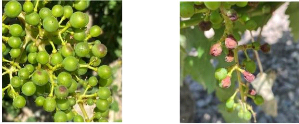1.2.2 Consequences of climate change on the Bordeaux
vineyard
The raise in temperatures will have a major effect on the
development speed of grapevine and its phenological stages. For the last 20
years, global warming has affected grapevine production causing an early
maturity date by 15 dates on average. Climate models predict the maturation
date for Merlot variety in Bordeaux to be 40 days ahead by the end of the 21st
century (Brisson and Levrault, 2010).
According to simulations done in the 2000's, there are no
evidence that climate change will impact the yield of the Bordeaux vineyard
(Garcia de Cortazar, 2006). However, grape quality might be impacted by
temperature and sun radiation intensity growth, as well as a potential water
deficit.
Climate change will also directly impact grapevine diseases as
it will force the pests and pathogens to adapt, and in the worst scenario
causing their multiplication (Thiery and Chuche, 2007).
As a consequence to the multiplication of intense heat events,
the quality of the produced wines might be affected. It has been proven that
they raise the potential alcohol, reduce the acidity, inhibit the anthocyanins
synthesis, and therefore affect the color and aromas of the produced wines
(Santos et al. 2020).
For now, those extreme temperatures can cause grape sunburn.
As this phenomenon is rising in France, it is already very important in other
winegrowing regions where the average yearly temperatures are way higher than
in France. For example, in Australia, this phenomenon is very common and
impacts each year 5 to 15% of the grape production, causing dramatic yield
losses. In Chile, up to 40% of bunches can show sunburn damage in sensitive
varieties like Muscat (Gambetta et al., 2021).
However, the economic consequences caused by grape sunburn can
be important. Consequently, many winemaking companies all over the world are
experimenting new potential solutions to diminish the grape sunburn problem.
2. State of the art of grape sunburn
2.1 Grape sunburn: definition, symptoms, and
consequences
Grape sunburn can be defined as a physiological disorder
affecting both the visual and organoleptic properties of grapes. Only the
bunches of grapes exposed to the sun can be affected by sunburn. It is
noticeable by the brown and necrotic spots on the grapes. Those spots alter the
commercial value of the fruit, but can also in extreme cases significantly
decrease the yield (Gambetta et al., 2021).
Symptoms associated with grape sunburn range from the
appearance of brown spots on the epidermis of grapes to the entire desiccation
of the berries (Suehiro et al., 2014). We can see on Figure 1, both
types of sunburn intensity (brown spots on the left and berries desiccation on
the right).
Sunburn damages the berry epidermal tissue at the epicuticular
and epidermal level. At the epicuticular level, it degrades the structure of
the skin waxes causing their degradation and allowing a higher skin
permeability, resulting in the dehydration and visual change of the grapes
(Bondada and Keller, 2012). At the epidermal level, it destroys chlorophyll -
causing a slight discoloration of the grapes - and induces cell
compartmentalization, exposing polyphenolic compounds to polyphenol oxidases.
As a result, the oxidation of polyphenols leads to the browning of the skin.
The browning of the skin is also caused by cell death in the epidermal layers
of the exocarp in the skin of the grapes (Olivares-Soto et al., 2020).

9
Figure 1: Observed symptoms of low-intensity (left)
and high-intensity (right) sunburn at Château Margaux in June
2022
Browning can strongly decrease the market value of the crop
and cause significant losses in quality of wine grapes. Sunburn mostly affects
the skin of the grapes with little to no effect on the pulp, apart from its
possible dehydration. However, sunburn can cause uneven ripening of the grape.
A study on Cabernet Sauvignon berries showed that temperatures above 30°C
can overall flavonoid content, and in particular the anthocyanin concentration,
leading to a decrease in anthocyanin concentration, affecting the wine color
(Pastore et al., 2013).
Sunburn browning is known to be the result of a combination of
both high light and high temperature on the sun-exposed side of the fruit
(Schrader et al., 2009). However, other factors can influence the temperature
as well as the sun exposure of the fruit during the vegetative period. Those
factors were classified in two categories, based on their durability.
| 


